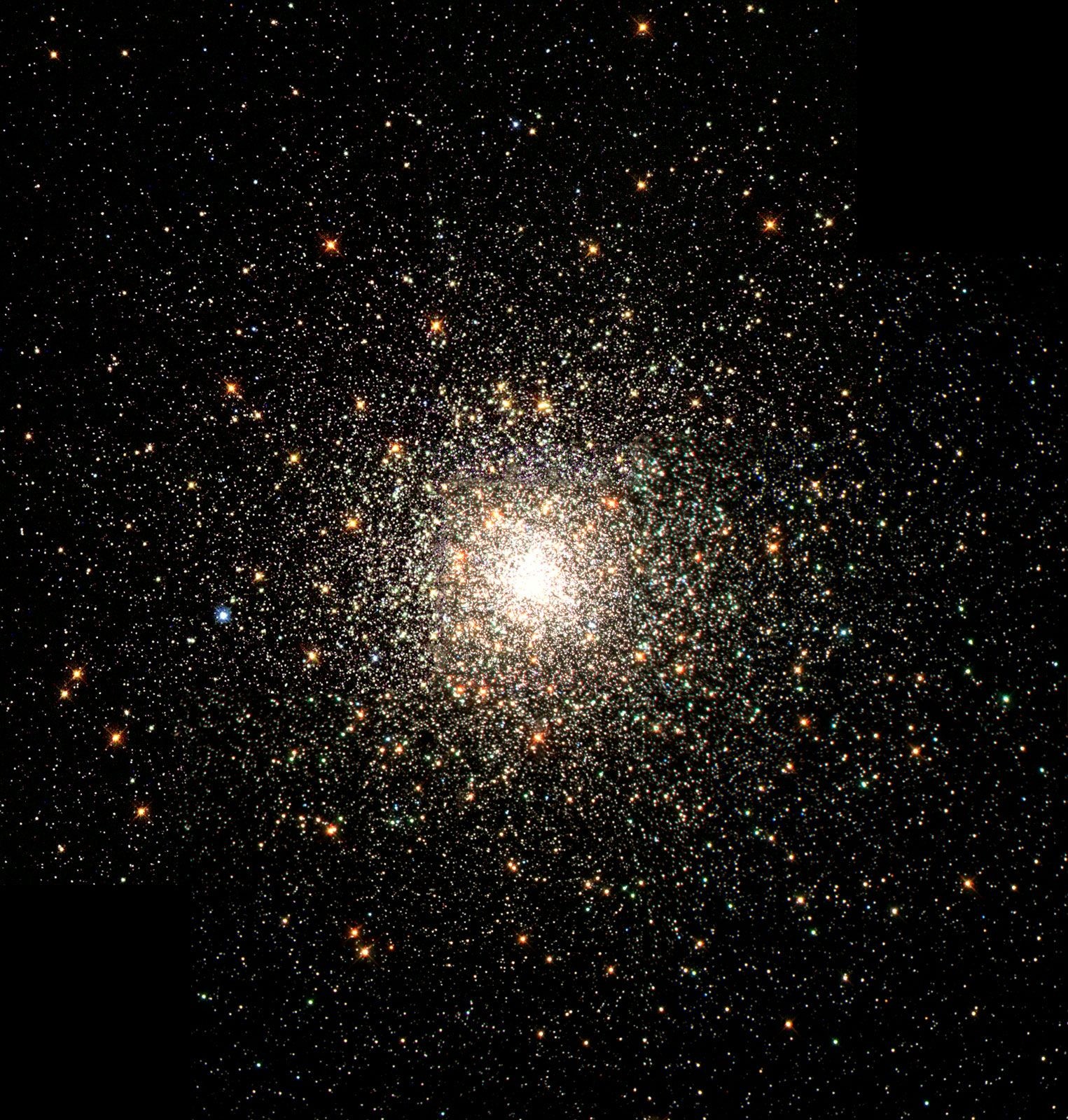Our galaxy, the Milky Way, is a vast and complex structure composed of numerous components. From star clusters to nebulae and dust clouds, these elements work together to shape the galaxy we call home. Let’s take a closer look at the major components that make up the Milky Way.
Star Clusters and Stellar Associations
Most stars in the Milky Way exist as single stars, like our Sun, or as binary star systems. However, there are also significant groupings and clusters of stars, ranging from tens to thousands of members. These groupings can be categorized into three main types: globular clusters, open clusters, and stellar associations, each differing in age and number of member stars.
Globular Clusters
Globular clusters are the largest and most massive star clusters, characterized by their spherical appearance. The Milky Way hosts over 150 globular clusters, arranged in a nearly spherical halo around the galactic center. These clusters are incredibly luminous, with a mean luminosity equivalent to about 25,000 Suns. Their masses range from a few thousand to over a million solar masses, and their diameters vary from 10 to 300 light-years.
A key feature of globular clusters is their uniformly old age, ranging from 11 to 13 billion years. This makes them the oldest objects in the Milky Way, believed to have formed early in the galaxy’s history. They are composed of stars belonging to Population II, which are stars with much smaller amounts of heavy elements compared to stars in the galactic plane like our Sun.
Open Clusters
Open clusters are smaller and less massive than globular clusters. They are found in the plane of the Milky Way, intermixed with the majority of the galaxy’s stars, including our Sun. Open clusters generally have a more open, loose appearance compared to globular clusters.
These clusters are distributed similarly to young stars, concentrated along the galactic plane and decreasing in number outward from the galactic center. Dust obscuration in the Milky Way plane makes it difficult to observe open clusters beyond a few thousand light-years from the Sun. The brightest open clusters are fainter than the brightest globular clusters, with peak absolute luminosity around 50,000 times the luminosity of the Sun. Their masses are typically small, on the order of 50 solar masses, with populations ranging from tens to a few thousand stars.
Open clusters are relatively short-lived, tending to be young objects, with only a few exceeding 1 billion years in age. Most are younger than 200 million years, and some are only 1 or 2 million years old. The Hyades, one of the nearest clusters to us, has almost twice the abundance of heavy elements as the Sun.
Stellar Associations
Stellar associations are even younger than open clusters. They are loose groupings of young stars that share a common origin but are not gravitationally bound enough to form a stable cluster. These associations are limited to the plane of the Milky Way and appear in regions of active star formation, particularly in the spiral arms.
Stellar associations are very luminous, sometimes brighter than the brightest globular clusters. However, this is due to the presence of very luminous, young stars of spectral types O and B, which have absolute luminosities up to a million times that of the Sun. These stars have very short lifetimes, lasting only a few million years. Stellar associations have relatively small total masses, typically a few hundred solar masses, with populations of hundreds or thousands of stars.
Their sizes are large, with an average diameter of about 250 light-years. Due to their loose structure, they disperse into surrounding space within a few million years, becoming separate and unconnected stars.
Moving Groups
Moving groups are stellar organizations that share common measurable motions, although they may not form a noticeable cluster. This definition includes gravitationally bound clusters and widely spread stars with no apparent gravitational connection. The Hyades, also known as the Taurus moving cluster or Taurus stream, is among the best-known moving groups. Other notable groups include the Ursa Major, Scorpius-Centaurus, and Pleiades groups.
Studying moving groups has advanced our understanding of stellar kinematics and the galactic distance scale. Their common motion allows for accurate distance determination of individual members, providing a basis for the galactic distance scale, complementing measurements from parallax stars.
Emission Nebulae
Emission nebulae are large, bright, diffuse gaseous objects, often called nebulae. These interstellar complexes of gas and stars feature gas in an ionized and excited state, energized by the intense ultraviolet light emitted by luminous, hot stars embedded within. These are also commonly referred to as H II regions because they consist almost entirely of ionized hydrogen.
H II regions are intermixed with young stars, stellar associations, and the youngest open clusters within the plane of the Galaxy. These are regions where massive stars have recently formed and often contain the uncondensed gas, dust, and molecular complexes associated with ongoing star formation. These regions are concentrated in the spiral arms, though some exist between the arms and can be mapped using their characteristic radio radiation.
Planetary Nebulae
Planetary nebulae are gaseous clouds that represent a stage at the end of a star’s life cycle. Their distribution differs from that of H II regions; they belong to an intermediate population and are found throughout the disk and inner halo. More than 1,000 planetary nebulae are known in the Galaxy, although more might be obscured in the Milky Way region.
Supernova Remnants
Supernova remnants are nebulous objects resulting from the gas ejected from an exploding star. While some resemble planetary nebulae, they differ in gas mass, expansion velocities, and lifetimes. Famous examples include the Crab Nebula, Tycho’s Nova, and Kepler’s Nova. These remnants are often detected at radio wavelengths due to synchrotron radiation emitted by charged particles moving spirally in a magnetic field.
Dust Clouds
Dust clouds in the Milky Way are narrowly limited to the galactic plane. Dust clouds beyond 2,000 to 3,000 light-years from the Sun cannot be detected optically due to obscuration by intervening dust. These clouds are often conspicuous within the spiral arms, particularly along the inner edge of well-defined arms.
More complete information comes from infrared observations. Infrared telescopes register long-wavelength radiation emitted by cool dust clouds themselves. Surveys like those conducted by the Infrared Astronomical Satellite (IRAS) and the Spitzer Space Telescope have revealed many dense dust clouds in the Milky Way, and have allowed astronomers to view massive star clusters still in the process of formation.
The General Interstellar Medium
The stars in the Milky Way are dimmed by interstellar dust, which obscures and reddens starlight. Stars near the Sun are dimmed by a factor of two for every 3,000 light-years. This dust also polarizes background starlight, likely due to dust grains aligned by the galactic magnetic field.
This interstellar gas consists mostly of hydrogen in its neutral form, detectable by radio telescopes due to its emission at a wavelength of 21 cm. This radio wavelength penetrates interstellar dust, providing insights into the large-scale structure and motions of the Galaxy. The average density of interstellar gas near the Sun is about one hydrogen atom per cubic centimeter.
Companion Galaxies
The Milky Way has companion galaxies, including the Magellanic Clouds. These were recognized as separate systems in the 20th century. The Large and Small Clouds are irregular galaxies more than 100,000 light-years distant. Additional close companions are small dwarf elliptical galaxies, such as the Sagittarius dwarf, which is falling into the Milky Way. The Andromeda Galaxy also has several dwarf companions, mirroring this grouping.
By understanding these major components, we gain a more comprehensive view of what the Milky Way is and its place in the vast universe.

